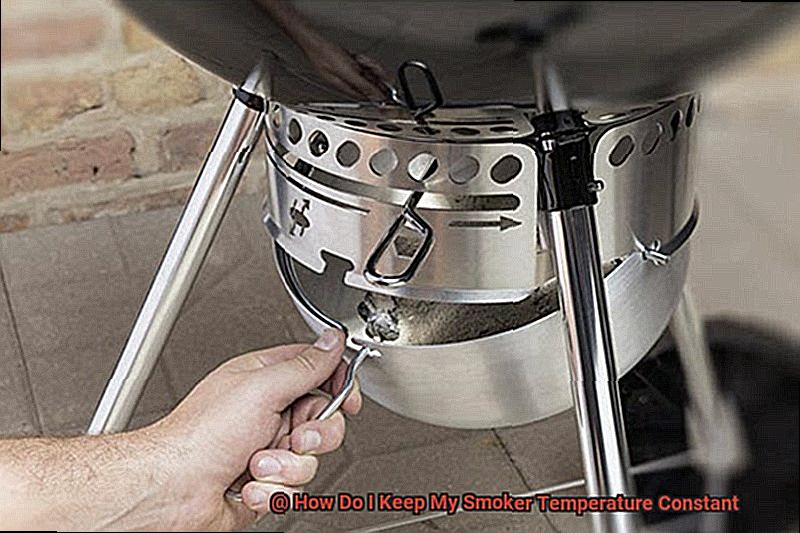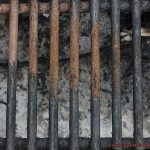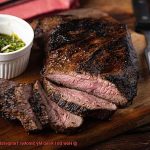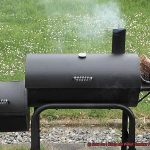Picture this: the mouthwatering aroma of slow-cooked meat wafting through the air, teasing your taste buds with every whiff. Smoking meat is an art form that requires patience and precision. The perfect slab of ribs or brisket requires just the right amount of heat and time for the meat to cook thoroughly while keeping it moist and juicy.
But here’s the thing – how do you keep the temperature of your smoker constant for hours at a time?
Maintaining a steady temperature in your smoker is crucial to achieving the perfect smoke. Sure, fiddling with vents and temperature controls can seem like a hassle, but trust us when we say it’s essential if you want to smoke your meat to perfection.
In this post, we’re diving deep into some essential tips and tricks to keep your smoker temperature consistent. From choosing the right fuel type to finding the ideal location for your smoker, we’ve got you covered. And if you’re facing common issues like temperature spikes or drops, don’t worry – we’ll help you troubleshoot them too.
So grab your apron, tongs, and let’s get smokin’. We promise that by the end of this post, you’ll be well-equipped with all the knowledge needed to keep your smoker running like a pro.
Contents
Factors to Consider when Maintaining Smoker Temperature
Smoking meat can be a labor of love, but the end result is undoubtedly worth it. However, maintaining the perfect smoker temperature can be tricky. There are several factors to consider when trying to achieve the ideal smoking temperature. Here are some of the most important things to keep in mind.
Firstly, the type of smoker you have plays a crucial role in maintaining temperature stability. Every smoker has a unique design and heating mechanism that can affect heat retention and distribution. For example, vertical water smokers require less fuel and effort to maintain a constant temperature compared to offset smokers. It’s important to understand your smoker type and its characteristics to get the best results.
Secondly, the type of fuel you use is another key factor in maintaining smoker temperature. Charcoal, propane gas, and wood chips are all popular fuels for smoking meat. Each fuel has its own unique qualities that can affect temperature consistency. For instance, wood chips burn hotter and faster than charcoal, requiring more frequent attention to maintain a consistent smoking temperature.
Thirdly, weather conditions can also impact smoker temperature stability. Windy conditions can cause heat loss in the smoker, while high humidity can make it harder to maintain a consistent temperature. Checking the weather forecast before starting your smoking session is essential. Additionally, adjusting the smoker’s airflow and fuel accordingly can help compensate for any weather-related changes.
Fourthly, the cooking method you use can also affect smoker temperature stability. Smoking low and slow requires a lower temperature over a longer period compared to hot and fast grilling. You will need to adjust the airflow and fuel accordingly to maintain the ideal smoking temperature.
Lastly, monitoring the temperature regularly is crucial in achieving perfect smoked meat. Use a reliable thermometer to check the temperature frequently and adjust the vents or add more fuel as needed. Avoid opening the smoker lid unnecessarily as this can cause heat loss and disrupt the cooking process.
Choosing the Right Fuel
Whether you’re a seasoned pro or just starting out, choosing the right fuel can make all the difference in your smoking game. Not only does it affect the temperature, but it also impacts the flavor of your food. Let’s explore the different types of fuels that can be used in a smoker, including wood chips, charcoal, and propane.
First on our list is wood chips. They are a popular choice for smoking because they come in a variety of flavors and can be used with any type of smoker. However, wood chips require frequent replenishing and can be challenging to maintain a consistent temperature with. If you’re looking for that classic smoky flavor, then wood chips are an excellent option to consider.
Next up is charcoal. It burns longer than wood chips and provides a steady heat source. However, regulating the temperature with charcoal can be tricky and requires more attention to maintain a consistent temperature. But if you’re willing to put in the extra effort, you’ll be rewarded with a delicious smoky flavor that will have your taste buds dancing.
Lastly, we have propane. It’s a convenient fuel option for smokers because it’s easy to control the temperature and requires less maintenance than other fuels. However, some people argue that propane doesn’t provide the same level of flavor as wood or charcoal. So if you’re looking for convenience over flavor, then propane might be the way to go.
When it comes down to it, choosing the best fuel for your smoker will depend on personal preference and the type of smoker you have. It’s important to experiment with different fuels and methods until you find what works best for you in terms of maintaining a consistent temperature and achieving your desired flavor profile.
In conclusion, smoking meat is an art form that requires patience and practice. Don’t be afraid to try new things and have fun with it. Here’s a quick recap of our fuel options:
- Wood chips: versatile and flavorful, but require frequent replenishing and can be challenging to maintain a consistent temperature.
- Charcoal: burns longer and provides a steady heat source, but requires more attention to regulate the temperature and achieve a smoky flavor.
- Propane: convenient and easy to control the temperature, but may not provide the same level of flavor as wood or charcoal.
Ensuring Proper Insulation
Look no further than ensuring proper insulation for your smoker. Proper insulation is essential in achieving consistent temperatures throughout the smoking process and achieving that perfect smoky flavor.
To start, it’s important to choose a smoker with a thick and well-insulated construction. Consider materials such as ceramic or heavy-duty steel, which are known for their excellent heat retention properties. These materials will keep the heat inside the smoker and prevent it from escaping, leading to consistent temperatures and a better smoking experience.
In addition to material choice, pay attention to the seal on your smoker’s door. A poor seal will allow heat to escape and cause temperature fluctuations. Regularly check the seal and replace it if necessary. A tight seal is essential in keeping the heat inside the smoker where it belongs.
Using a high-quality gasket material can also help improve insulation and prevent heat loss. Choose a gasket material that is designed for high-temperature applications and is compatible with your smoker’s design. There are many options available, including silicone, fiberglass, and felt.
Lastly, consider using a thermal blanket or wrap to cover your smoker during use. These products trap heat inside the smoker, reducing the impact of external factors such as wind or cold temperatures. This helps maintain a consistent temperature inside the smoker throughout the entire cooking process.
Monitoring Regularly
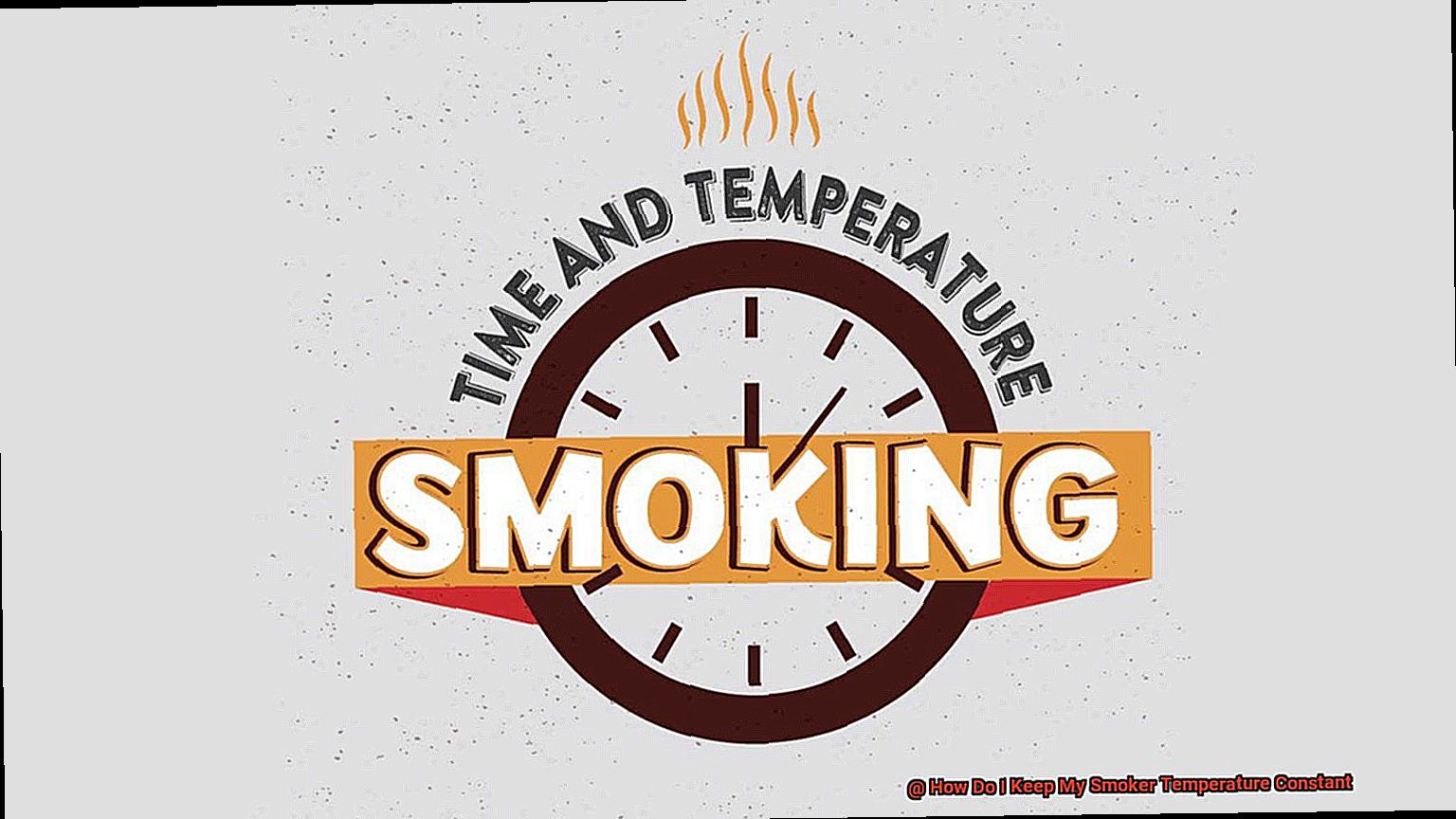
Then it’s time to master the art of monitoring your smoker temperature regularly. But don’t worry, it’s not rocket science. By following a few simple tips and tricks, you’ll be able to achieve mouth-watering, perfectly cooked smoked meat every time.
First and foremost, investing in a reliable thermometer is essential. With so many options available on the market, from digital to analog to wireless, there’s sure to be one that meets your needs and budget. A thermometer will help you keep track of the temperature inside the smoker and make necessary adjustments to maintain your desired temperature.
But don’t stop there. Keeping an eye on the smoke coming out of the smoker is just as important. Thin, blue smoke means that the wood is burning efficiently and that the temperature inside the smoker is balanced. In contrast, thick, white smoke is a sign of trouble with airflow or fuel and can cause fluctuations in temperature that affect your meat’s flavor.
To avoid these temperature fluctuations, it’s crucial to check fuel levels regularly. Adding too much fuel can cause the temperature inside the smoker to rise, while adding too little can cause a drop in temperature. Therefore, it’s best to keep a steady supply of fuel on hand and add it in small amounts at regular intervals.
In summary, here are some key points to remember when monitoring your smoker temperature:
- Invest in a reliable thermometer.
- Keep an eye on smoke color – thin and blue is ideal.
- Check fuel levels regularly and add in small amounts.
- Maintain a constant temperature throughout the smoking process for flavorful results.
Using a Water Pan or Heat Sink
Then, using a water pan or heat sink could be just what you need to take the stress out of smoking.
The water pan method involves filling a pan with water and placing it inside the smoker. As the water heats up, it creates steam which helps regulate the temperature inside the smoker. Not only does this method help keep your smoker temperature consistent, but it also adds moisture to your meat, preventing it from drying out. Plus, using a water pan is an affordable and easy way to regulate temperature in your smoker.
On the other hand, a heat sink is a material that absorbs and distributes heat evenly throughout the smoker. This method can be achieved by placing bricks, ceramic tiles or even cast iron skillets in the smoker. By doing so, they help maintain a consistent temperature by absorbing and releasing heat as needed. One important thing to keep in mind when using a heat sink is to ensure even distribution of the materials inside the smoker.
Both methods require careful attention to ensure that the water or heat sink doesn’t run out during the smoking process. It is important to monitor the water level or check on the heat sink periodically to ensure it is still functioning properly.
But wait, there’s more. Did you know that using a water pan or heat sink can also add flavor to your meat? Infusing your water with herbs, spices, or even beer can add an extra layer of deliciousness to your meat. And using certain types of wood chips in your water pan can also add smoky flavor to your meat.
Benefits of Keeping Smoker Temperature Constant
When it comes to smoking meat, the temperature is everything. It’s the difference between a mouth-watering, perfectly cooked piece of meat and a dry, flavorless disaster. That’s why keeping your smoker temperature constant is crucial for achieving that perfect balance of smokiness, tenderness, and juiciness in your meat.
Let’s explore some of the benefits of maintaining a constant smoker temperature:
Consistency is key. When you have a consistent temperature, you can be sure that your meat will cook evenly and will have the same level of doneness throughout. This is especially important when cooking larger cuts of meat like brisket or pork shoulder. You want every bite to be just as delicious as the last, and a steady temperature helps make that happen.
Saving time is another advantage of keeping your smoker temperature constant. Constantly adjusting the temperature adds more time to your cook. By keeping the temperature consistent, you can reduce your overall cooking time and get your meat on the table faster. Plus, who doesn’t love saving time when it comes to cooking?
Better flavor is yet another reason why maintaining a constant smoker temperature is essential. A steady temperature allows for a consistent burn of wood chips or pellets, resulting in just the right amount of smokiness in your meat. When the temperature fluctuates too much, it can cause the wood to burn too quickly or too slowly, resulting in less-than-ideal flavor.
Finally, keeping your smoker temperature steady gives you more control over the cooking process. You can adjust the temperature up or down as needed to achieve the desired level of doneness without worrying about drastic fluctuations that could ruin your meal.
Tips for Setting Up and Maintaining Your Smoker
Smoking meat is a time-honored tradition that can result in deliciously tender and flavorful food. However, to achieve perfect results, you need to ensure that your smoker maintains a constant temperature throughout the cooking process. Here are some tips for setting up and maintaining your smoker to achieve a consistent temperature.
Proper Preparation for a Clean Smoker
Starting with a clean and well-maintained smoker is crucial to achieving a consistent temperature. Remove any ash or debris from previous uses, and inspect your smoker for any signs of damage. A clean smoker will ensure that your fuel burns evenly and produces consistent heat throughout the cooking process.
Choose the Right Fuel
Different fuels produce varying levels of heat, so experiment with different types to find the one that works best for your smoker and the type of meat you’re cooking. Once you’ve chosen your fuel, make sure you have enough to last throughout the entire cooking process. This will help maintain a consistent temperature without having to add more fuel frequently.
Ensure Proper Insulation
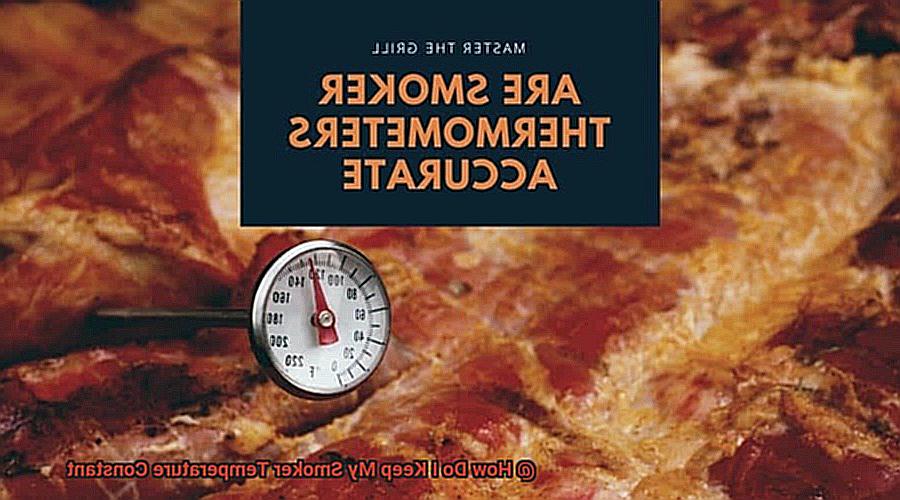
Poor insulation can cause heat loss and temperature fluctuations in your smoker. Check for gaps or leaks in the smoker’s body, doors, and vents, and seal them with high-temperature silicone or gaskets. Additionally, make sure that your smoker has enough ventilation to allow for proper airflow.
Monitor Regularly for Temperature Fluctuations
Use a reliable thermometer to check the temperature regularly and adjust the vents or add more fuel as needed. Avoid opening the smoker lid unnecessarily as this can cause heat loss and disrupt the cooking process. Remember that small adjustments in airflow or fuel can have a significant impact on your smoker’s temperature.
Use Additional Tools for Consistent Temperature
Consider using additional tools like a water pan or heat sink in your smoker. These can help regulate the temperature by absorbing excess heat and releasing it slowly over time. A water pan can also add moisture to the cooking environment, keeping your meat juicy and tender.
Common Mistakes to Avoid when Smoking Meat
Smoking meat is an art form that requires patience, attention to detail, and a keen understanding of the process. While it may seem like a simple task, there are some common mistakes that can make or break your smoked meat. As an expert in smoking meat, I’ve compiled a list of the most common mistakes to avoid to ensure your meat is cooked to perfection.
First and foremost, resist the urge to open the smoker too often. While it’s tempting to check on your meat frequently, every time you open the smoker door, heat escapes, and the temperature drops. This can cause fluctuations in temperature, leading to uneven cooking. Try to limit how often you open the smoker door to maintain a constant temperature.
In addition, not using enough fuel is another mistake that can ruin your smoked meat. Without enough charcoal or wood chips, your smoker will struggle to maintain a consistent temperature. It’s important to have enough fuel before starting the process and keep an eye on the fuel level throughout the smoking process.
Regulating airflow is also crucial for maintaining a consistent temperature. If there isn’t enough airflow, the fire will smolder and produce less heat, while too much airflow will cause the fire to burn too hot and fast. Look for a smoker with adjustable vents and regulate them accordingly.
Finally, failing to monitor the temperature regularly is a common mistake that can result in unevenly cooked meat. Even if you set your smoker temperature at the start, it’s important to keep an eye on it throughout the smoking process and make adjustments as needed.
To summarize:
- Limit how often you open the smoker door
- Ensure you have enough fuel before starting and keep an eye on the fuel level
- Regulate the airflow with adjustable vents
- Monitor the temperature regularly
How to Tell if Your Smoker is Running Too Hot or Too Cold
For those who love the flavor of smoked meat, mastering the art of smoking requires attention to detail and the ability to maintain a consistent temperature in your smoker. This is because temperature fluctuations can result in dry and undercooked meat or burned and overcooked meat. Therefore, it’s important to know how to tell if your smoker is running too hot or too cold.
One way to gauge the temperature of your smoker is by using a thermometer. You can use a built-in thermometer or invest in a good-quality thermometer for accurate readings. Place the thermometer at the grate level where you’ll be cooking and monitor the temperature regularly. If the temperature is higher than desired, open the vents to cool down the smoker, and if it’s lower than desired, open the vents to increase heat or add more fuel.
Another way to tell if your smoker is running too hot or too cold is by observing the smoke produced by your smoker. Thin and wispy smoke indicates that your smoker may be running too hot, while thick and billowy smoke suggests that your smoker may be running too cold. Adjusting the airflow can usually help regulate the temperature and smoke production.
Pay close attention to the appearance of your food as well. Overcooked or burnt meat can be a sign that your smoker is running too hot, while undercooked meat could indicate that your smoker is running too cold. Use a meat thermometer to ensure that your food has reached a safe internal temperature.
When adjusting the temperature of your smoker, it’s important to make small changes gradually. Sudden adjustments can lead to overcorrection and fluctuating temperatures, which can ruin your meal. Instead, make small adjustments and wait for 10-15 minutes before checking the temperature again.
The Best Thermometers for Measuring Smoker Temperature
As a grill master, you know that maintaining a consistent temperature in your smoker is the key to creating perfectly cooked, mouth-watering meats. However, with so many types of thermometers available, it can be challenging to determine which one is best for measuring smoker temperature. Let’s dive into the different types of thermometers and their pros and cons.
Firstly, we have the classic dial thermometer. While this type of thermometer can be accurate, it may not always be the best option for monitoring smoker temperature. It can take a long time to give an accurate reading, which can be problematic if you’re making real-time adjustments to your smoker. Additionally, opening the smoker to check the temperature can cause heat loss and disrupt the cooking process.
A better option for measuring smoker temperature is a digital probe thermometer. This type of thermometer has a probe that is inserted into the meat and then connected to a digital display outside the smoker. This allows you to monitor the temperature in real-time without having to open the smoker and lose heat. Digital probe thermometers come in various models, so look for ones with long cords and easy-to-read displays for maximum convenience while smoking your meats.
Another type of thermometer that can be useful for measuring smoker temperature is an infrared thermometer. These thermometers work by measuring the surface temperature of the meat or smoker. While they are quick and easy to use, they may not be as accurate as other types of thermometers.
Ultimately, the best thermometer for measuring smoker temperature will depend on your specific needs and preferences. If you’re looking for speedy readings, an infrared thermometer might be your best bet. If you’d rather avoid heat loss and keep an eye on your smoker’s temperature from afar, opt for a digital probe thermometer. And if you’re a fan of classic thermometers, go for a dial thermometer.
Different Types of Fuel and Their Effects on Smoker Temperature
Smoking meat is a time-honored cooking method that requires patience and attention to detail. Achieving the perfect flavor and texture of smoked meat heavily relies on the type of fuel you use in your smoker. Let’s explore how different types of fuel can affect the temperature of your smoker and ultimately influence the quality of your food.
Wood is a classic and popular fuel choice for smokers because it infuses a natural smoky flavor to the meat. However, not all woods are created equal when it comes to temperature. Hardwoods like oak and hickory burn hotter and longer than fruitwoods like apple or cherry. The moisture content of the wood also plays a significant role in temperature control. Wet or green wood will create more smoke but will burn cooler than dry wood. Therefore, using the right amount of dry hardwood can help maintain a consistent temperature in your smoker.
Charcoal is another commonly used fuel that offers an even burn and consistent heat source for smokers. Lump charcoal, made from hardwood, burns hotter than briquettes, which are typically made from compressed sawdust and other materials. If you’re using lump charcoal in your smoker, you may need to adjust the amount you use to maintain a consistent temperature. Briquettes tend to burn at a lower temperature and may require more frequent refueling to keep the temperature steady.
Propane is an efficient fuel option for smokers that provides precise temperature control with the turn of a dial. However, some barbecue purists argue that propane doesn’t produce the same smoky flavor as wood or charcoal. Nevertheless, propane can be a valuable asset for novice smokers who struggle with maintaining consistent temperatures.
Regardless of the fuel type, using high-quality fuel is crucial for maintaining a steady smoker temperature. Cheap fuels may contain additives or fillers that can negatively affect the temperature and overall quality of your food.
To ensure a consistent smoker temperature, proper insulation and ventilation are essential for proper airflow. Monitoring the temperature with a reliable thermometer and using water pans or heat sinks can also help regulate the temperature and keep your meat juicy and tender.
Conclusion
If you’re serious about smoking meat, then keeping the temperature consistent is key.
Whether it’s using a digital thermometer, adjusting the air intake vents, or adding more fuel at regular intervals, there are plenty of ways to maintain that perfect temperature.

